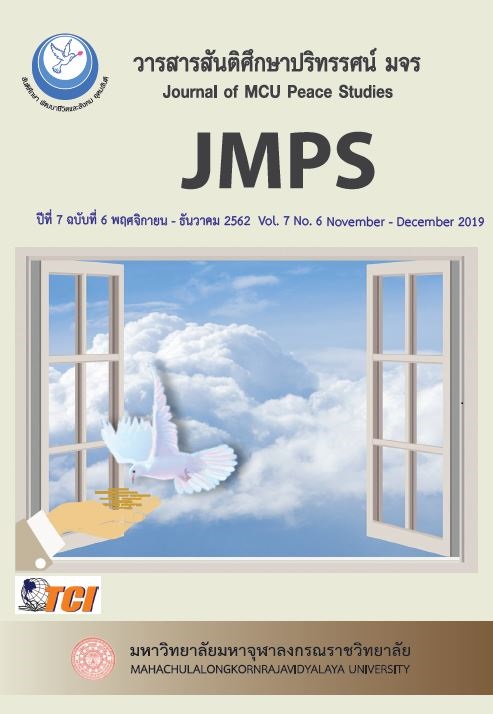การส่งเสริมการพัฒนาและติดตามการดำเนินงานโรงเรียนผู้สูงอายุ
Main Article Content
บทคัดย่อ
การวิจัยครั้งนี้มีวัตถุประสงค์คือ 1) เพื่อดำเนินการส่งเสริมการจัดตั้งโรงเรียนผู้สูงอายุในพื้นที่ดำเนินการ 2) เพื่อติดตามการดำเนินงาน การให้คำปรึกษา และสนับสนุนการจัดตั้งโรงเรียนผู้สูงอายุ และ3) เพื่อนำเสนอผลการดำเนินงานโรงเรียนผู้สูงอายุ การวิจัยครั้งนี้เป็นการวิจัยเชิงปฏิบัติการแบบมีส่วนร่วม มีผู้ให้ข้อมูลประกอบด้วย 3 กลุ่มหลักคือ 1) หน่วยงานในฐานะผู้สนับสนุนการจัดตั้งโรงเรียนผู้สูงอายุ 2) คณะผู้บริหารและคณาจารย์ของโรงเรียนผู้สูงอายุ 3) ผู้เรียนสูงอายุที่กำลังเรียนหลักสูตรโรงเรียนผู้สูงอายุ และสมาชิกในครอบครัวของผู้เรียนสูงอายุ วิเคราะห์ข้อมูลโดยการวิเคราะห์เนื้อหา ผลการวิจับพบว่า 1) การส่งเสริมการจัดตั้งและพัฒนาการดำเนินงานโรงเรียนผู้สูงอายุ เพื่อให้เกิดผลลัพธ์ที่ถูกต้องเหมาะสมนั้นในเชิงกระบวนการ ได้แก่ การค้นหาบุคคลและพื้นที่ที่สนใจ การสร้างความเข้าใจในกระบวนการบริหาร การระดมเครือข่ายความร่วมมือ และการพัฒนารายวิชา 2) การติดตามการดำเนินงาน การให้คำปรึกษา และสนับสนุนการจัดตั้งโรงเรียนผู้สูงอายุ จะเน้นที่บทบาทของคณะนักวิจัย โดยการเป็นพี่เลี้ยงสะท้อนได้จากบทบาทของการให้คำปรึกษา การให้ความรู้ การให้การสนับสนุน เป็นผู้ชี้นำ 3) การดำเนินงานและการบริหารจัดการหลักสูตรโรงเรียนผู้สูงอายุ เป็นการสำรวจข้อมูลผู้เรียนและใช้ประโยชน์จากข้อมูล การบริหารหลักสูตรอย่างยืดหยุ่น เทคนิคการสอน การใช้สื่อการสอน และการประเมินผลที่หลากหลาย ทั้งนี้ ตัวแบบที่เหมาะสมสำหรับการจัดตั้งโรงเรียนผู้สูงอายุในชุมชนคือ ตัวแบบการจัดตั้งแบบผสม (ภาครัฐและภาคประชาชน) ตลอดจนผลการศึกษานำมาพัฒนาสู่การจัดทำคู่มือการจัดตั้งโรงเรียนผู้สูงอายุ
Article Details
ทัศนะและความคิดเห็นที่ปรากฏในบทความในวารสาร ถือเป็นความรับผิดชอบของผู้เขียนบทความนั้น และไม่ถือเป็นทัศนะและความรับผิดชอบของกองบรรณาธิการ ยินยอมว่าบทความเป็นลิขสิทธิ์ของวารสาร
เอกสารอ้างอิง
Buys, L., & Miller, E. (2012). Active Ageing: Developing a Quantitative Multidimensional Measure. in Active Ageing, Active Learning: Issues and Challenges, eds.
Chanabamrung, U. (2012). Role of executive roles in curriculum development. Retrieved January 10, 2019, from https://www.gotoknow.org/posts/511837.
Foundation of Thai Gerontology Research and Development Institute. (2008). Situation of the Thai elderly. Retrieved September 12, 2019, from http://thaitgri.org/?p=36158
Khampuk, P., & Srirungruang, P. (2015). The opinions of those involved in the establishment of the elderly school in Hua Ngom Subdistrict, Phan District, Chiang Rai Province. Chiang Rai: Chiang Rai Rajabhat University.
Ministry of Social Development and Human Security. (1999). Declaration on Thailand's older persons. Retrieved August 5, 2018, from http://www.dop.go.th/download/laws/law_th_20152309154750_1.pdf.
Ministry of Social Development and Human Security. (2007). Elderly Person Act, B.E. 2546. Retrieved August 5, 2018, from http://www.dop.go.th/download/laws/regulation_th_20160807155130_1.pdf.
National Elderly Promotion and Coordination Committee. (2002). National Elderly Plan. Bangkok: Prime Minister's Office.
Sangsri, S. (2001). Lifelong education for Thai society in the 21st century. Bangkok: National Institute of Educational Technology.
Santiwong, T. (2000). Organization and administration. Bangkok: Thai Wattana Panich.
Srisuphan, P., Tharmikornworn, S., & Krishnajutha, S. (2017). Elderly school and the development of the elderly potential in Isan local community. Journal of Developmental Science, 14(1), 133-162.
Walker, A. (2002). A strategy for active ageing. International Social Security Review, 55(1), 121-139.
Wiyaphon, K. (2010). The development of non-formal education activities according to the concept of intellectual education to enhance the health of the elderly. Bangkok: Chulalongkorn University.
Wongyai, W. (2002). Curriculum development and teaching. Bangkok: Srinakharinwirot University.
World Health Organization. (2002). Active Aging, A Policy Framework. A Contribution of The World Health Organization to the Second United Nation World Assembly on Ageing, Madrid, Spain, April.
Yodpet, S., Pattanasri, P., & Sakdapon, T. (2017). Lesson learning, good examples of schools and elderly clubs with knowledge transfer activities. Bangkok: Thai Health Promotion Foundation.


